Friday, August 9, 2013
"Rainforests were my childhood obsession," Rosolie told Mongabay.com. "For as long as I can remember, going to the Amazon had been my dream […] In those first ten minutes [of visiting], cowering under the bellowing calls of howler monkeys, I saw trails of leaf cutter ants under impossibly large, vine-tangled trees; a flock of scarlet macaws crossed the sky like a brilliant flying rainbow. I saw a place where nature was in its full; it is the most amazing place on earth."
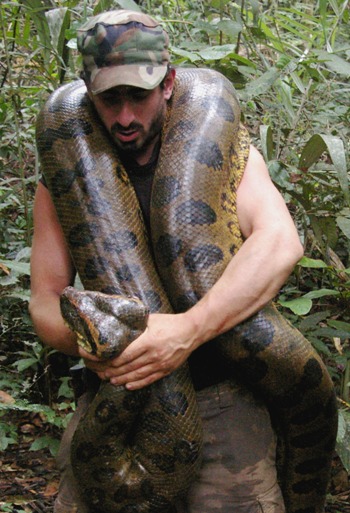 Paul Rosolie inspecting a 15ft+ female for facial parasites such as ticks. Photo courtesy of Paul Rosolie. |
Recently, the local tribe sent Rosolie and Duran to a place both legendary and ecologically marvelous: a massive lake with a "raft of vegetation and grass which supports a smaller dwarf forest," Rosolie says. The ecosystem is strong enough to walk on—at least in parts.
"Walking on the floating forest at night is a surreal and very spooky experience. The floating part isn’t very stable, one wrong step and you get plunged into the lake. It was an intimidating place but with careful navigation we found a completely alien environment. As we walked, we passed only the tops of the aguaje palms whose base lay rooted to the lake’s floor forty or fifty feet below," he says.
While this unique ecosystem is home to a number of animals, including "three species of caiman, two species of owl, numerous fish (which we were unable to identify), and a tremendous tarantula population"—all seen on the first night—the big (literally) inhabitants are the anacondas.
During their first expedition to the dwarf forest, Duran and Rosolie came upon the biggest anaconda they have ever encountered: "We spotted two tremendous anacondas. The largest was more than double the size of the largest anaconda [Duran] and I have ever measured (15ft 4 inches). She was so large it would have taken eight people to restrain her on land; on the floating forest there was no chance. When she saw us she started moving away. We both wrapped our arms around her and did our best to restrain her for measurements and documentation, but it was like trying to stop a bus, she was way too strong. She bolted for the water with us holding onto her. Hanging on longer would have meant following her into the water below the floating forest. We were left soaked and panting – in complete disbelief of what we had just seen."
 Anaconda close-up. Photo by Gowri Varanashi. |
"Snakes measuring over twenty feet are extremely rare," Rosolie says, "this one was a living legend. In future explorations, once again spotting her will be one of my primary goals."
Rosolie believes that the dwarf forest on the lake may be an anaconda mating ground, given the number of snake tracks they have seen there and the lack of suitable prey.
"To my knowledge, and the knowledge of the people of Infierno, there is nowhere like it the region," Rosolie says.
Rosolie's volunteer trips, named Tamandua Expeditions, helps raise eco-tourism funds for the Infierno people, whose area is threatened by development, road building, oil leases, hunting, bushmeat demand, and gold mining.
"We have raised money that has contributed to permanently protecting a 7000 square hectare area of primary forest,” explains Rosolie. “Recently we have begun a new project within the Infierno community itself. By basing volunteer expeditions on Infierno territory we are supporting the community’s ambitions to pursue revenue through ecotourism. This, combined with the discovery of the floating forest ecosystem has helped convince community decision makers to abandon plans of creating several new roads into primary forest areas.”
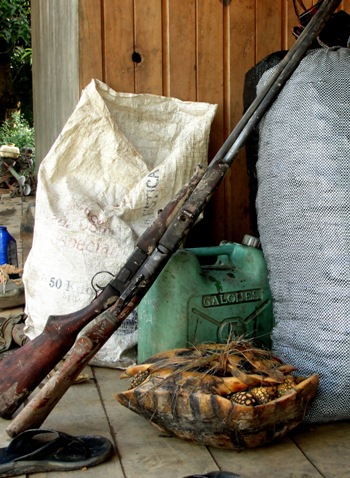 A yellow footed tortoise, one of the most threatened species in the area. This individual was destined for the soup pot, but was rescued and released by Tamandua. Photo by Gowri Varanashi. |
"For my friends in Infierno, seeing the interest and appreciation which visitors have for their home (the rainforest) and way of life, is an eye opening experience. They take great pride in showing volunteers the ways of the forest, skills such as how to observe animals, what fruits and nuts are edible, what vines are needed to make brooms and hats, and how to use a machete for just about everything," says Rosolie, who adds that education and the desire to draw eco-tourists has led to a decline in hunting by the Infierno.
"I try to lead volunteers on an adventure that they will never forget - which is thankfully the one easy part," Rosolie says of his expeditions. "When people see fire-red macaws crossing the sky for the first time, or explore the giant buttress roots of a kapok tree, or find themselves holding a live spectacled caiman, I know that the jungle has done my work for me – they are hooked."
In a March interview with Mongabay.com, Paul Rosolie spoke about his expeditions into the Amazon, the local Infierno community, anacondas and black caiman, grassroots conservation work, and his recent discovery of a strange floating dwarf forest thriving on a carpet of vegetation.
AN INTERVIEW WITH PAUL ROSOLIE
Mongabay:How did you become interested in wildlife? What is your background?
 A tapir emerging from the river and heading for the cover of the forest. Photo by Paul Rosolie. |
I couldn’t have been more than eight years old when I remember hearing about a species of turtle of which there was only one left. The species was about to go extinct. As a child who loved wildlife above all else, it was the most terrible thing I had ever heard. It was my first encounter with the concept of extinction. To think that any species could be gone forever at the hands of humans was more than I could fathom. That story made an impression on me which never left; I have been passionate about conservation ever since.
And while I always found classrooms dull, my dissatisfaction with conventional education reached its peak during sophomore year of high school. So, with my parents’ encouragement (can you believe that!) I left high school and started college. Soon after turning eighteen I followed my dream of visiting the Peruvian Amazon. There I fell in love with the pristine primary forests of the Madre de Dios lowlands. But it was later that same year, while on a study abroad program through Columbia University in the Brazilian Atlantic Forest that I learned the true value of what I had experienced in Peru. The near total destruction and complete fragmentation of the once great biome was a sobering contrast to what I had seen in the Amazon. It instilled a fear in me which was reinforced by similarly grim images of rainforest decimation which I encountered during work in Indonesia and India. It is because of these experiences that I have chosen to dedicate myself to defending the Amazon.
I will be finishing my undergraduate in environmental studies at Ramapo College of New Jersey this May.
Mongabay:You first volunteered in the Amazon at the young age of eighteen—what drew you there?
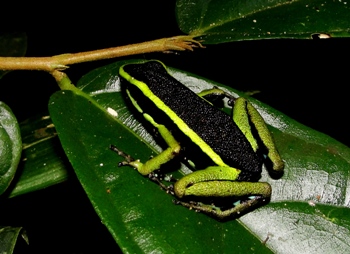 An arrow frog. Photo by Gowri Varanashi. |
Mongabay:How do you balance your conservation work in Peru with your studies back in the US?
Paul Rosolie:So far I have been restricted to running trips between semesters and during the summer. I use my time at school in the states to recruit volunteers and plan expeditions.
Mongabay:How did you end up working with the Infierno people on Peru's Tambopata River?
Paul Rosolie:My good friend and partner in Tamandua expeditions is a man named Juan Julio Duran (or JJ). He was one of the expedition leaders of my first trip to the jungle. I began learning from him and as our friendship grew, I became more and more familiar with his family and the other members of the community. Over the past few years I have tagged along on numerous expeditions into indigenous hunting grounds with men from Infierno. During these forays, mostly in the Tambopata Reserve and Bahuaja-Sonene Natinal Park, they would search for peccary, fish, and forest foul to hunt; I would search for wildlife to study and photograph. It was then that I honed my jungle skills, and became addicted to the indescribable feeling of being truly deep in the jungle, away from civilization for days on end.
THE DWARF FOREST AND ANACONDAS
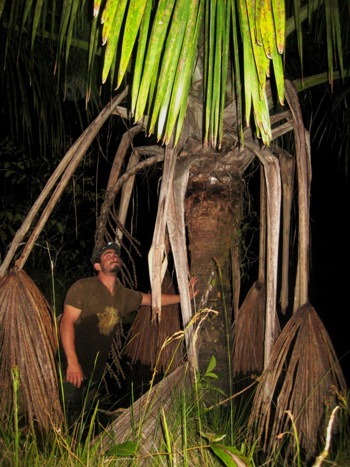 Normally 50+ feet in the air, the top of this aguaje palm stands only several feet from the surface of the lake - and the floating vegetation that covers it. Soaked to the chest from a night of exploring and plunging, I am standing next to it for scale. Photo courtesy of Paul Rosolie. |
Paul Rosolie:For years I had been hearing about a lake that was somehow special. Everyone in the community had a profound respect for it because it was rumored to have tremendous anacondas and full grown giant black caiman. I suspected all the hype to be mostly exaggeration. But when we launched our first exploration of the place, we instead found the legends to be understated. The lake is huge, and is surrounded by a palm forest swamp system that stretches for miles. But the most incredible part is that floating on top of the water’s surface is a raft of vegetation and grass which supports a smaller dwarf forest. This "raft" is tremendous, we still don’t know its exact size, but it is arranged in a patchwork that covers over 80% of the lake’s surface. Acting as support pillars for the vegetation raft and dwarf forest, are the tops of aguaje palm trees which are rooted to the lake’s bottom.
Walking on the floating forest at night is a surreal and very spooky experience. The floating part isn’t very stable, one wrong step and you get plunged into the lake. It was an intimidating place but with careful navigation we found a completely alien environment. As we walked, we passed only the tops of the aguaje palms whose base lay rooted to the lake’s floor forty or fifty feet below. The value of this ecosystem as an isolated habitat was immediately evident to us, and during the night of our first exploration we recorded three species of caiman, two species of owl, numerous fish (which we were unable to identify), and a tremendous tarantula population. To my knowledge, and the knowledge of the people of infierno, there is nowhere like it the region.
Mongabay:Will you also tell us about your first encounter with anacondas in the lake?
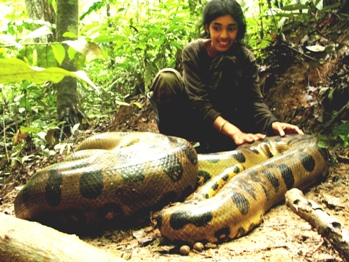 A volunteer demonstrating the placid nature of the world's largest snake species. Photo by Paul Rosolie. |
Mongabay:How many anacondas have you found in this strange ecosystem? What is the largest you have recorded?
Paul Rosolie:From catching 15ft individuals on a fairly regular basis, we have a good frame of reference to verify that the female was saw that first night was significantly larger than double any we had previously encountered. The only actual measurement we have is that my arms barely touched around her body and I have a 6’ arm span. This means that the snake had a girth of something like 70 inches. We estimate her length to be easily upwards of 25ft. Snakes measuring over twenty feet are extremely rare; this one was a living legend. In future explorations, once again spotting her will be one of my primary goals. Although we have been seeing evidence (tracks) of 25ft+ range individuals in extremely remote areas forest for years, actually photographing and documenting an anaconda of that size would be huge!
Mongabay:What ecological significance do you think this place has?
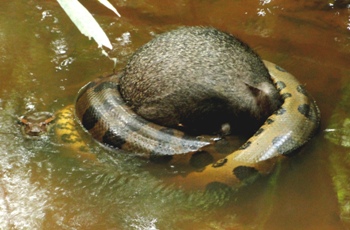 A large female anaconda with its constricted prey - a collared peccary. Spending the dry months in the sanctuary of the floating forest, this female was found during January at the base of an active mammal colpa, taking advantage of the abundance of food. Photo by Gowri Varanashi. |
Because the floating forest hosts a large migration of an apex predator species, this location most likely impacts the surrounding ecosystem in a profound way. Since anacondas are born very small and grow very large, their predation affects many levels of the food chain. Their usual diet includes caiman, birds, agoutis, capybara, peccary, monkeys, and much more. There was even a confirmed case of a dead anaconda found with a nine foot boa constrictor in its stomach. Other species found around the floating forest habitat include peccary, tapir, ocelot, giant armadillo, giant anteater, puma, and tyra among others.
Read more athttp://news.mongabay.com/2010/0310-hance_rosolie.html#F3cybv5VllAJRCuY.99
Subscribe to:
Posts (Atom)
